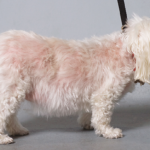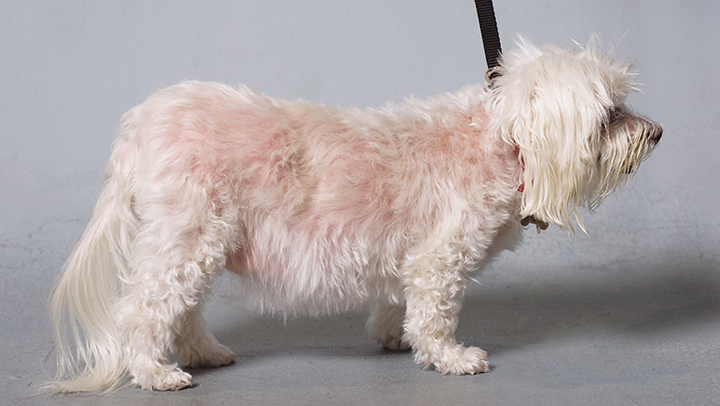Signs of hormonal disorders in dogs can be the followings:
- Increased thirst (needing water bowl filled more often; drinking from ponds or puddles)
- Change in appetite (increase or decrease)
- Change in coat (altered color, different texture, hair loss)
- Recurrent skin infections
- Weight gain, weight loss, or inability to lose or gain weight (changes may be subtle, developing over a long time)
- Lethargy and tiredness (may not be related to aging)
Hormones are chemicals released into the bloodstream by various glands to carry messages to body tissues and organs. Most hormonal disorders occur through overproduction or underproduction of these chemicals.
Diabetes Mellitus
Insulin is a hormone produced by the pancreas to control the level of glucose in the blood. A deficiency in insulin results in diabetes mellitus, or “sugar diabetes.” Common signs of diabetes mellitus are ravenous hunger, weight loss, abnormal thirst, and frequent passing of large volumes of urine.
Occasionally, the first indication may be loss of vision due to a cataract (clouding of the lens of the eye). Sometimes, the disorder may not be diagnosed until a dog becomes unwell from complications arising from diabetes mellitus and has to undergo examinations.
Diabetes mellitus is treated with injections of insulin, together with regular feeding and exercise. Many owners are initially worried about injecting their dogs, but this soon becomes part of the daily routine.
A female may develop diabetes mellitus after being in heat. Neutering may be the cure, provided there are enough insulin-produc
ing cells remaining in the pancreas.
Obesity is another risk factor for developing diabetes mellitus. The disorder seems to be more common in certain breeds, such as the miniature and toy Poodles, some terriers, and Samoyeds.
Hypothyroidism
In this condition, there is underproduction of the hormones produced by the thyroid gland in the neck. Hypothyroidism tends to
develop in middle-aged dogs, but may appear at a younger age in breeds predisposed to the disorder, such as Irish Setters, English Sheepdogs, Dobermans, and Boxers.
Hypothyroidism can have diverse effects. Typical signs of an underactive thyroid gland include weight gain that is difficult to reverse and lethargy. There may be changes in coat color, thinning of the coat leading to fur loss, and skin infections. Hypothyroidism is diagnosed from blood tests and treated with thyroid hormone replacement, given by tablet.
Cushing’s Syndrome

Mostly seen in middle-aged or older dogs, Cushing’s syndrome is the result of abnormally high blood levels of cortisol—a hormone produced by the adrenal glands.
Signs are increased appetite and thirst, increased urination, hair loss, development of a pot-belly, and blackheads on the skin.
There may be slow healing of wounds, breathlessness, and lethargy. Diagnosis is based on blood and urine tests, X-rays, and ultrasound. Treatment is usually with drugs; if an adrenal tumor is the cause of the high cortisol levels, surgery may be possible.
Addison’s Disease
In Addison’s disease the adrenal glands do not produce enough of the hormones cortisol and aldosterone. The deficiency interferes with the balance of sodium and potassium in the blood, and affects the ability to cope with stress.
The disease typically affects young or middle-aged female dogs and is sometimes caused by sudden withdrawal of corticosteroid drugs.
Signs of Addison’s disease can be vague: vomiting, diarrhea, loss of appetite, weight loss, and increased thirst. Occasionally, these signs become much more severe, and the dog collapses in a so-called “Addisonian crisis.”
Diagnosis is by blood and urine tests; treatment involves hormone replacement with tablets, and monitoring with regular blood screening.
Dwarfism
The hormone that regulates growth is produced by the pituitary gland, situated just beneath the brain.
In the congenital disorder known as dwarfism, there is underproduction of this growth hormone and normal development is affected. In a puppy with dwarfism, the head, body, and limbs may all be in proportion but undersized; or just one area of the body, such as the legs, may be abnormal.
The adult coat does not grow, so alopecia develops as the puppy coat is lost and not replaced. The dog has a shrill bark, and may show no signs of sexual maturity.
Dwarfism can be treated with injections of growth hormone together with supplementation of thyroid hormone. Affected dogs have a shortened lifespan.
Learn more about signs of hormonal disorders in dogs by clicking HERE.

